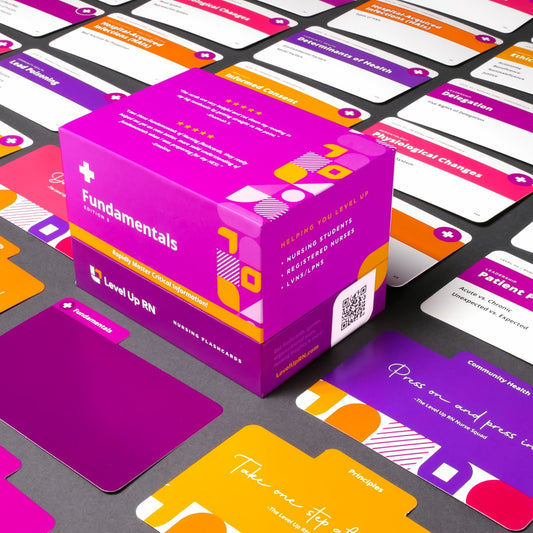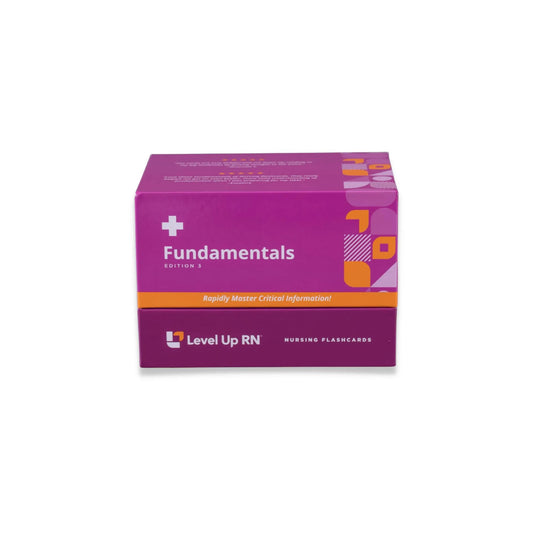Fundamentals of Nursing - Flashcards
This article covers dysphagia, therapeutic diet types, prevention of foodborne illnesses, and capillary blood glucose measurement. You can follow along with our Fundamentals of Nursing flashcards, which are intended to help RN and PN nursing students study for nursing school exams, including the ATI, HESI, and NCLEX.
Dysphagia
Dysphagia is a condition where a patient has difficulty swallowing. This means the patient is at an increased risk for aspiration (when something enters the airway or lungs by accident). Solids or liquids could end up going down the trachea instead of the esophagus, which is a choking risk.
Risk factors of dysphagia
There are many risk factors for dysphagia, including nervous system disorders (e.g., stroke, Parkinson’s, dementia, ALS (also known as Lou Gehrig's disease, a myotrophic lateral sclerosis, is a progressive neurodegenerative disease that affects nerve cells in the brain and spinal cord), cerebral palsy, head/neck/esophageal injury, and GERD (gastroesophageal reflux disease).
Signs and symptoms of dysphagia
The signs and symptoms of dysphagia include sustained coughing and clearing of the throat.
The patient may be “pocketing,” which is when food remains in the buccal pocket or buccal pockets (the space between the gum and the cheek).
If they have difficulty eating or drinking, this is a red flag that the patient may be experiencing dysphagia.
Nursing care for patients with dysphagia
Nursing care is very important for a patient with dysphagia.
Assess the patient for swallowing issues at admission (prior to providing any food/liquids).
You can learn more about the flow and sequence of a head-to-toe patient assessment with our Health Assessment Flashcards for Nursing Students.
A patient experiencing dysphagia needs to see a speech-language pathologist for a full swallow evaluation and, possibly, swallowing therapy.
The patient should consume thickened liquids and possibly be placed on a dysphagia diet, which is covered more in depth below.
A patient in hospital should have the head of their bed raised and be put in high Fowler’s position.
Types of therapeutic diets
A therapeutic diet is any kind of a diet that’s prescribed or per order. A patient in the hospital will usually be on a therapeutic diet.
NPO
NPO is an acronym of a Latin term — nil per os (or null per os) — meaning, nothing by mouth. That means the patient should ingest nothing by mouth, including liquids. Nothing goes in.
Clear liquid diet
A clear liquid is a liquid that is transparent and liquid at room temperature — anything that is liquid at room temperature that a light will pass through. A clear liquid diet includes juices like grape juice, apple juice, and cranberry juice, which don't have any pulp or sediment. Also: black coffee, tea, water, broth (not a creamy soup), clear sodas, popsicles, ice chips and jello.
Full liquid diet
Full liquids are any kind of liquid. So, in addition to the clear liquid items listed above are things like orange juice or milk, coffee with creamer, and ice cream.
Soft diet
A soft diet is comprised of soft foods. These foods are low fiber, so they are easily digested, and include low-fat dairy, eggs, pudding, bland vegetables, tofu, and lean skinless meats.
Dysphagia diet
A dysphagia diet includes soft foods that are moistened or pureed, as well as thickened liquids.
Regular diet
A regular diet consists of a normal-consistency intake, the sort of foods that a patient would eat at home.
Prevention of foodborne illness
The prevention of foodborne illnesses includes the following (patient) teaching:
- Hand hygiene — wash hands after using the bathroom and prior to food preparation
- Wash fruits and vegetables thoroughly prior to preparing or eating
- Use separate equipment to prepare raw meats and cooked foods
- Use a meat thermometer to ensure meat is thoroughly cooked
- Refrigerate perishables within 2 hours of purchasing or cooking (or within 1 hour when the outside temp > 90°F)
- Ensure the refrigerator is ≤ 40°F and the freezer is ≤ 0°F
Capillary blood glucose (CBG) measurement
Capillary blood glucose (CBG) measurement is the measurement of a patient's blood glucose level, using blood from a fingertip puncture. A glucometer — an at-home blood-sugar monitoring device — is used to measure the patient’s CBG.
The following are best practices for using a glucometer to assess a patient’s CBG:
- Clean the site (fingertip) with an alcohol swab, then allow skin to dry completely
- Lower the patient’s hand to encourage bleeding
- Hold the lancet to the skin at the lateral, distal end of the fingertip (not the pad of finger)
- Wipe away the first drop of blood with gauze
- Gently touch the test strip to a drop of blood without smearing the blood
- Following the collection of the blood sample, apply pressure to the puncture site with dry gauze
- Dispose of the test strip and lancet appropriately (e.g., sharps box) when done
You can learn about blood glucose labs and more with our Lab Values Study Guide & Flashcard Index, a list of lab values covered in our Lab Values Flashcards for nursing students, an easy reference guide.



1 comment
I love the way you teach in just few minutes. These videos are so helpful. Thanks alot. God bless you. Keep posting.